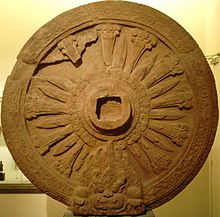ദ്വാരാവതി
ദ്വാരാവതി The Dvaravati (Thai: ทวารวดี, rtgsrtgs: ThawarawadiThawarawadi) കാലഘട്ടം ആറാം നൂറ്റാണ്ടുമുതൽ പതിമൂന്നാം നൂറ്റാണ്ടുവരെയാണ്. ദ്വാരാവതി എന്നാൽ സംസ്കാരത്തെയും ഇവിടത്തെ ഭരണവ്യവസ്ഥയെയും അർത്ഥമാക്കുന്നുണ്ട്.



ചരിത്രം
തിരുത്തുകദാരാവതിയിലെ മോൺ രാജ്യം അഞ്ചാം നൂറ്റാണ്ടിൽ ഉദയം കൊണ്ടു. ഫ്രാ പന്തോം, ഫോങ് തുങ് എന്നീ ബുദ്ധമതപ്രദേശങ്ങൾ ഈ രാജവംശം തങ്ങളുടെ അധീനതയിലാക്കി.[1] രാജകിയമായ പാത്രങ്ങളിൽ കൊത്തിവച്ചതുപ്രകാരം, താഴെപ്പറയുന്ന രാജാക്കാന്മാർ ആയിരുന്നു ഭരണം നടത്തിയിരുന്നത് എന്നുകാണാം: സൂര്യവിക്രമ (673-688), ഹരിവിക്രമ (688-695), സിംഹവിക്രമ (695-718).[2] 937ലെ ഒരു ഖമർ എഴുത്തിൽ ചനസപുത്ര രാജകുമാരന്റെ രേകഹ കാണാവുന്നതാണ്. ഇതിൽ ഭഗദത്ത എന്ന രാജാവിൽ തുടങ്ങി സുന്ദരവർമൻ അദ്ദേഹത്തിന്റെ മക്കളായ നരപതിസിംഹൻ, മങള വർമൻ എന്നിവരിൽ അവസാനിക്കുന്നു.[3] പക്ഷെ ആ കാലത്ത്, പത്താം നൂറ്റാണ്ടിൽ, ദ്വാരാവതി ഖമർ സ്വാധീനത്തിലായി. മദ്ധ്യ തായ്ലന്റ് പന്ത്രണ്ടാം നൂറ്റാണ്ടിന്റെ ആദ്യ പകുതിയിൽത്തന്നെ സൂര്യവർമ്മൻ രണ്ടാമന്റെ അധീനതയിലായി.[4] ഹരിപുൺചായ് ലണ്ണ രാജ്യവുമായുള്ള സഖ്യത്തിൽ തന്റെ രാജ്യം അധീനതയിലാകാതെ നിലനിർത്തി.[5] ഈ പ്രദേശത്തെ ജനങ്ങൾ മോൺ ഭാഷയാണുപയൊഗിച്ചിരുന്നതെങ്കിലും അവർ മോൺ ജനതയായിരുന്നോ എന്ന കാര്യത്തിൽ സംശയമുണ്ട്. ഈ പ്രദേശത്തെ ജനങ്ങൾ ഖമർ, മലയ് തുടങ്ങിയ അനേകം വ്യത്യസ്ത വംശങ്ങളിൽ പെട്ടതായിരുന്നുവെന്ന് തെളിവുകളുണ്ട്. ദദ്വാരാവതിയിലേയ്ക്ക് മലയ് വംശജർ കുടിയേറി എന്ന ധാരണ ചിലർ അവതരിപ്പിക്കുന്നുണ്ടെങ്കിലും അത് വളരെപ്പിന്നീട് നടന്നതാണേന്നു തെളിവുണ്ട്.
ദ്വാരാവതി എന്ന വാക്ക് അവിടെ ഉപയോഗിച്ചിരുന്ന നാണയങ്ങളിലെഴുതിയ പേരുമൂലം ഉണ്ടായതാണ്. സംസ്കൃതത്തിലാണിത് ദ്വാരാവതി എന്ന് എഴുതിയിരിക്കുന്നത്. സംസ്കൃതത്തിൽ ദ്വാരാവതി എന്നതിനർത്ഥം ഗേറ്റുള്ളത് എന്നാണ്. [6]:301 (ദ്വാര dvāra "door, gate, entrance"). പുരാതന ഇന്ത്യയിലെ ദ്വാരക എന്ന നഗരത്തിന്റെ പേരിൽനിന്നുമായിരിക്കാം ദ്വാരാവതി എന്ന പേരുണ്ടായത്.I
ദ്വാരാവതിയുടെ ഭരണസംവിധാനത്തെപ്പറ്റി അധികമൊന്നുമറിയില്ല. ഒരു കേന്ദ്രീയ ഭരണസംവിധാനമായിരുന്നില്ല, പകരം അയഞ്ഞ അനേകം ചെറുപ്രദേശങ്ങളോ ചെറുരാജ്യങ്ങളോ ചേർന്ന ഒരു സംവിധാനമായിരുന്നു. ഉയർന്ന ഉപദ്വീപീയ പ്രദേശത്തെ തീരപ്രദേശങ്ങൾതൊട്ട് ചാവോഫ്രായ നദിയുടെ തീരപ്രദേശങ്ങൾ വരെ കിടക്കുന്ന രാജ്യമായിരുന്നു ദ്വാരാവതി. ഹിന്ദുമതവും ബുദ്ധമതവുമായിരുന്നു. അന്നത്തെ പ്രധാനമതങ്ങൾ. നഖോൺ പഥോം, സുഫൻബുരി, പ്രാക് ശ്രീഗജ എന്നിവയായിരുന്നു പ്രധാനമായ മൂന്നു ജനപഥങ്ങൾ. ഇവ കൂടാതെ താഴെപ്പറയുന്ന ഇടങ്ങളിലും ചെറിയ ജനപഥങ്ങളുണ്ടായിരുന്നു. യു തോങ്, ചാൻസെൻ, ഖു ബുവ, പോങ് തുക്, മുവാങ് ഫ്രാ റോട്, ലോപ്ബുരി, സി മഹാസോദ്, കംഫയെങ് സയെൻ, ഡോങ് ലഖോർൺ, യു-തഫാവോ, ബൻ ഖു മുവാങ്, ശ്രീ തെപ് എന്നിവിടങ്ങളിലായിരുന്നു അവ.:303–312
കല
തിരുത്തുകദ്വാരാവതിയെ ഇന്ത്യൻ സംസ്കാരം ആഴത്തിൽ സ്വാധീനിച്ചിരുന്നു. ഇന്ത്യയിൽ നിന്നും ബുദ്ധമതവും അതിലൂടെ ബുദ്ധിസ്റ്റ് കലയും അവിടെയെത്തി. മതപരമായ ആലയങ്ങളിൽ ഗരുഡമാർ, മകരം, നാഗങ്ങൾ എന്നിവയുടെ ശില്പങ്ങൾ കൊത്തിവയ്ക്കപ്പെട്ടു. ഇതിനുപുറമേ, തങ്ങളുടെ വാദ്യോപകരണങ്ങലുമായി അനേകം ഗായകരേയും തടവുകാരേയും തങ്ങളുടെ പരിചാരകരോടുകൂടി സ്ത്രീകളേയും സൈനികരേയും ചിത്രീകരിച്ചു. അന്നത്തെ സാമൂഹ്യ ജീവിതത്തിന്റെ പരിശ്ചേദമായിരുന്നു ഈ ചിത്രങ്ങളും ശില്പങ്ങളും. മൺപലകകൾ, പാത്രങ്ങൾ, ടെറാക്കോട്ട ട്രേകൾ, ഓട്ടുവിളക്കുകൾ, കാതിലിടുന്ന കമ്മലുകൾ, മണികൾ, കൊട്ടുന്ന ഓട്ടുകൈമണികൾ എന്നിവയും അവിടെ നിന്നും ലഭിച്ചിട്ടുണ്ട്. :306–308
അവലംബം
തിരുത്തുക- ↑ ലുവ പിഴവ് ഘടകം:Footnotes-ൽ 80 വരിയിൽ : bad argument #1 to 'ipairs' (table expected, got nil)
- ↑ ലുവ പിഴവ് ഘടകം:Footnotes-ൽ 80 വരിയിൽ : bad argument #1 to 'ipairs' (table expected, got nil)
- ↑ ലുവ പിഴവ് ഘടകം:Footnotes-ൽ 80 വരിയിൽ : bad argument #1 to 'ipairs' (table expected, got nil)
- ↑ "The Mon-Dvaravati Tradition of Early North-Central Thailand". The Metropolitan Museum of Art. Retrieved 2009-12-15.
- ↑ David K. Wyatt and Aroonrut Wichienkeeo. The Chiang Mai Chronicle, p.33
- ↑ Higham, C., 2014, Early Mainland Southeast Asia, Bangkok: River Books Co., Ltd., ISBN 9786167339443
ഗ്രന്ഥസൂചിക
തിരുത്തുകകൂടുതൽ വായനയ്ക്ക്
തിരുത്തുക- Robert L. Brown, The Dvaravati Wheels of the Law and the Indianization of South East Asia. Studies in Asian Art and Archaeology, Vol. 18, Fontein, Jan, ed. Leiden and New York: E. J. Brill, 1996.
- Elizabeth Lyons, “Dvaravati, a Consideration of its Formative Period”, R. B. Smith and W. Watson (eds.), Early South East Asia: Essays in Archaeology, History and Historical Geography, Oxford University Press, New York, 1979, pp. 352–359.
- Dhida Saraya, (Sri) Dvaravati: the Initial Phase of Siam's History, Bangkok, Muang Boran, 1999, ISBN 974-7381-34-6974-7381-34-6
- Swearer, Donald K. and Sommai Premchit. The Legend of Queen Cama: Bodhiramsi's Camadevivamsa, a Translation and Commentary. New York: State University of New York Press, 1998. ISBN 0-7914-3776-00-7914-3776-0
- สุรพล ดำริห์กุล, ประวัติศาสตร์และศิลปะหริภุญไชย, กรุงเทพฯ: สำนักพิมพ์เมืองโบราณ, 2004, ISBN 974-7383-61-6974-7383-61-6.
- Pierre Dupont, The Archaeology of the Mons of Dvāravatī, translated from the French with updates and additional appendices, figures and plans by Joyanto K.Sen, Bangkok, White Lotus Press, 2006.
- Jean Boisselier, “Ū-Thòng et son importance pour l'histoire de Thaïlande [et] Nouvelles données sur l'histoire ancienne de Thaïlande”, Bōrānwitthayā rư̄ang MỮang ʻŪ Thō̜ng, Bangkok, Krom Sinlapakon, 2509 [1966], pp. 161–176.
- Peter Skilling, "Dvaravati: Recent Revelations and Research", Dedications to Her Royal Highness Princess Galyani Vadhana Krom Luang Naradhiwas Rajanagarindra on her 80th birthday, Bangkok, The Siam Society, 2003, pp. 87–112.
- Natasha Eilenberg, M.C. Subhadradis Diskul, Robert L. Brown (editors), Living a Life in Accord with Dhamma: Papers in Honor of Professor Jean Boisselier on his Eightieth Birthday, Bangkok, Silpakorn University, 1997.
- C. Landes, “Pièce de l’époque romaine trouvé à U-Thong, Thaïlande”, The Silpakorn Journal, vol.26, no.1, 1982, pp. 113–115.
- John Guy, Lost Kingdoms: Hindu Buddhist Sculpture of Early Southeast, New York and Bangkok, Metropolitan Museum of Art and River Books, 2014, p. 32.
- Wārunī ʻŌsathārom. Mư̄ang Suphan bon sēnthāng kan̄plīanplǣng thāng prawattisāt Phutthasattawat thī 8 - ton Phutthasattawat thī 25 (History, development, and geography of the ancient city of Suphan Buri Province, Central Thailand, 8th-25th B.E.), Samnakphim Mahāwitthayālai Thammasāt, Krung Thēp, 2547.